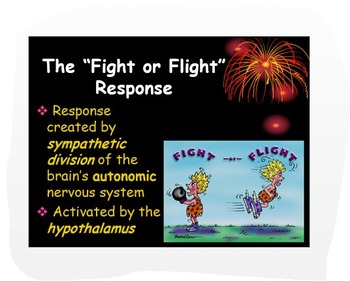Psychology: Fight or Flight Response w/Critical Thinking PowerPoint
Engaging Language Arts and Psychology
188 Followers
Grade Levels
9th - 12th, Higher Education, Adult Education, Homeschool
Subjects
Resource Type
Standards
CCSSCCRA.SL.1
CCSSCCRA.SL.2
CCSSCCRA.SL.4
CCSSCCRA.SL.6
CCSSRST.9-10.1
Formats Included
- PPTX
Pages
4 pages
Engaging Language Arts and Psychology
188 Followers
Description
This is a 2013 MS PowerPoint slide presentation, which could easily be reproducible as handouts, on the fight or flight response. You may use thisin a Psych I or II unit on the physiological response of fight vs. flight, and include the final slide activity I have written and presented here, OR countless others of your own choosing. This is an interactive, highly graphic and colorful cohesive set of slides with custom animation and transitions for concise student viewing and lesson application. The PPT includes a hyperlink to a printable website of physiological/hormonal changes in fight or flight mode.
With the final slide application activity, students will be invited to develop the Common Core 21st Century skills, including critical thinking; they will thus be working within the higher levels of Bloom's Taxonomy (eg. moving beyond understanding to application, analysis, and evaluation)!
Please let me know how you find this helpful in your Psychology course(s), and any additional feedback you wish to share. YOu may find this useful to pair with the PPT I offer also on Conflict, Stress, and Coping, which would work well together within a unit in Psychology on same. Thanks so much for visiting my store!
With the final slide application activity, students will be invited to develop the Common Core 21st Century skills, including critical thinking; they will thus be working within the higher levels of Bloom's Taxonomy (eg. moving beyond understanding to application, analysis, and evaluation)!
Please let me know how you find this helpful in your Psychology course(s), and any additional feedback you wish to share. YOu may find this useful to pair with the PPT I offer also on Conflict, Stress, and Coping, which would work well together within a unit in Psychology on same. Thanks so much for visiting my store!
Total Pages
4 pages
Answer Key
Does not apply
Teaching Duration
30 minutes
Report this resource to TPT
Reported resources will be reviewed by our team. Report this resource to let us know if this resource violates TPT’s content guidelines.
Standards
to see state-specific standards (only available in the US).
CCSSCCRA.SL.1
Prepare for and participate effectively in a range of conversations and collaborations with diverse partners, building on others’ ideas and expressing their own clearly and persuasively.
CCSSCCRA.SL.2
Integrate and evaluate information presented in diverse media and formats, including visually, quantitatively, and orally.
CCSSCCRA.SL.4
Present information, findings, and supporting evidence such that listeners can follow the line of reasoning and the organization, development, and style are appropriate to task, purpose, and audience.
CCSSCCRA.SL.6
Adapt speech to a variety of contexts and communicative tasks, demonstrating command of formal English when indicated or appropriate.
CCSSRST.9-10.1
Cite specific textual evidence to support analysis of science and technical texts, attending to the precise details of explanations or descriptions.





